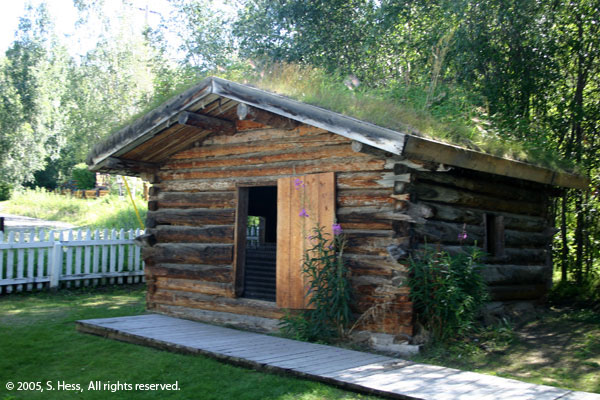| Dawson City is located at the confluence of the Klondike and Yukon Rivers. It became the focal point of the Klondike Stampede, the Gold Rush of 1898. Gold had been discovered at Bonanza Creek, a few miles outside of Dawson. The news of that discovery reached the outside world and started a mass migration of people seeking to find their fortunes. Most came by boat to Skagway or Dyea, Alaska and then had to take one ton of supplies over the Chilkoot or White pass to British Columbia. These passes were difficult and the trip had to be made many times in order to get their supplies into Canada. Once there, the stampeders had to get down the Yukon River, another difficult journey. We met a couple who had retraced the steps of the stampeders by hiking the Chilkoot Trail (unlike the stampeders, only once), then canoed down through a series of lakes and the Yukon River to Dawson. It took this couple several weeks to make the journey.
Dawson City can only be described as an experience. Walking through the town is like going back in time to 1898 and the gold rush. Many of the buildings were built during the period of the gold rush and other, newer, buildings were built in the style of the original structures. The streets are unpaved and the sidewalks are wooden. We walked through the town a number of times just snapping away with the cameras. We also attended some of the cultural events such as an evening at Diamond Tooth Gerties, Canada's oldest casino, an interpretive talk on Jack London, author of The Call of the Wild, and a silent movie in the Grand Palace Theater.
We chose to combine the pictures from both days of our stay into one page because it really didn't matter what day we took the pictures of the town to get the feeling of the area.
|
|
|
|
|
|
 |
|
|
|
|
|
This poem by Robert Service says it all
|
|
|
The Rivers
|
|
 |
|
 |
|
|
Confluence of the Klondike and Yukon Rivers
Klondike in foreground, Yukon in back
|
|
|
Klondike River upstream of its mouth
|
|
 |
 |
|
|
Waters of the Yukon and Klondike mixing downstream of the confluence. Yukon water is silt laden and the Klondike is clear and green
|
|
Bonanza Creek near our campground. The gold that triggered the stampede was found a few miles from here.
|
|
|
Jack London
|
|
|
|
Jack London lived in the Yukon for one year. While he didn't get rich from the gold, the Yukon influenced his life and made him the top selling author of his time. His most famous book is The Call of the Wild and that book influenced many people's images of the Yukon River and its environs. The cabin in which Jack London spent a winter was disassembled and logs from it were used to construct replicas in Dawson and in Oakland, California, his birthplace.
|
|
|
|
 |
|
|
 |
|
|
|
|
|
Jack London's cabin at the Jack London Center, above
|
|
|
Food and fur cache built on stilts to keep animals from getting to it, right |
|
|
Dawson City Scenes
|
|
|
 |
|
 |
|
| These buildings' foundations were placed directly on the ground. The heat from the buildings melted the permafrost and cause the settling. |
Building under construction shows methods keep the heat from melting the permafrost. |
|
 |
 |
|
 |
 |
|
|
|
|
|
 |
|
|
 |
|
 |
|
 |
|
 |
 |
|
 |
 |
|
 |
 |
|
 |
 |
|
 |
 |
|
 |
 |
|
 |
 |
|
 |
 |
|
|
Fun Stuff
|
|
|
 |
|
 |
|
|
|
Sam and friends
|
|
|
|
|
|
|
|
|
|
|
|
|
|
|
|
|
|
|
|
|
|
|
|
|
|
|
|
|


































